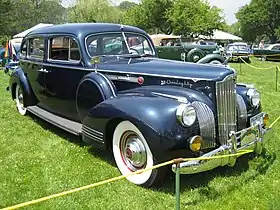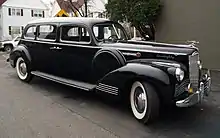Packard 180
The Packard 180 was introduced for the 1940 model year (18th series) by the Packard Motor Car Company to replace the discontinued Packard Twelve as their top-of-the-line luxury model. The correct name of the model was Custom Super Eight One-Eighty. The car was derived from the Packard Super Eight One-Sixty with which it shared the complete running gear including the in-line eight-cylinder, 356-cubic-inch (5,830 cc) engine that developed 160 horsepower. It was advertised as the most powerful eight-cylinder engine offered by any automobile manufacturer in 1940. (By contrast, the Cadillac 346 cubic inch V-8 developed 150 hp). It was complemented and gradually replaced by the more modern looking and expensive Packard Clipper in 1941 and fully replaced by the Custom Eight after the war.
| Packard One-Eighty | |
|---|---|
 1941 Packard One-Eighty Touring Sedan | |
| Overview | |
| Model years | 1940–1942 |
| Body and chassis | |
| Body style |
|
| Layout | Front-engine, rear-wheel-drive |
| Powertrain | |
| Engine | 356 cu in (5.8 L) I8 |
| Transmission | 3-speed manual |
| Dimensions | |
| Wheelbase |
|
| Chronology | |
| Predecessor | Packard Twelve |
| Successor | |
Packards of all series (110, 120, 160, 180) shared similar body styling in 1940 (which some later said led to a "cheapening" of the once-exclusive luxury marque), using the same bodies with hoods and front fenders of different length to meet their respective chassis. Thus the 160 and 180 got identical bodies. However, the 180s featured finer interior detailing with the best fabrics, leather, and carpeting available. Packard used a special woolen ceiling in these cars only which was sewn longitudinally. Packard built the partition in its Limousines in a way that there was no hint of it when the partition glass was lowered, allowing the owner to use the car by himself as a sedan (thus the designation "Sedan Limousine" by Packard).
.jpg.webp)
In 1940, Packard made air conditioning an option. It was developed by the Henney Motor Company, with whom Packard had a long-standing business connection. Air conditioning had been used on Henney-bodied ambulances as early as 1938. It was the first time that air conditioning was available on a stock automobile. The Packard 180 was also the first car to have power windows.
In an exclusive agreement with Packard from 1937 until Henney's demise in 1954, Henney provided bodies for Packards's ambulances, hearses and flower cars, and they often provided special custom bodywork for passenger cars. The pre-World War II Henney models usually had 160-180 trim but were actually constructed on the Packard 120A 156" wheelbase chassis with the smaller 288 cubic inch engine although there were also 160 and 180 versions available.

There were minor styling changes in the 1941 and 1942 models (19th and 20th series), the most notable of which were the moving of the headlamps into the fenders. Also for the first time, running boards could be deleted with a rocker panel put in their place to cover the chassis, and two-tone paint schemes were available. New for 1941 was the Electromatic Drive, a vacuum-operated clutch system for the conventional 3-speed manual transmission. Packard's own automatic transmission, the Ultramatic, would not be ready until 1949.
The final 180s rolled off the Packard assembly line in February 1942, as production restrictions of World War II brought a halt to civilian automobile production. There have been rumors that machinery was transferred to the Soviet Union, and production continued until 1959 as the ZIS-110. James Ward found no supporting evidence in the Packard archives of such a transfer.[1] Also, the ZIS-110 shares no sheet metal with any Packard,[2] despite the fact that its external decor elements were intentionally designed to heavily resemble pre-war Packards, favoured by Stalin after he had received a Packard Twelve as a gift from Franklin D. Roosevelt.[3]
A black 1941 Packard One-Eighty Super Eight was featured in The Godfather.
Darrin-bodied cars
.jpg.webp)
Designer Howard "Dutch" Darrin had made a few special bodies on Packard-basis, beginning in 1937. He tried to sell Packard on the idea of Darrin-bodied cars being offered directly by Packard, and finally got his way after parking one if his creations outside the Packard dealers' annual conference.[4] For the 1940 model year, three Darrin bodystyles were available: the closed four-door Sport Sedan, the four-door Convertible Sedan, and the two-door Convertible Victoria. About 100 Packard Darrins were built until 1942, when production of private cars ended because of the war. This was much fewer than planned.[4]
Building even this number of cars would have overstretched Darrin's Hollywood workshops so they were built by American Central Manufacturing - one of the last remnants of the Auburn-Cord-Duesenberg conglomerate - in Connersville ("Little Detroit") Indiana instead. Darrin would travel back and forth between California and Indiana supervising construction. This work was shifted to Sayers & Scovill in Cincinnati (the company became Hess & Eisenhardt in 1942) to let ACM concentrate on building Jeep bodies.[5] Between 59 and 72 Packard Darrins were built in 1940, of which 44 (or 48) were One-Eightys and the remainder One-Twentys.[4] For the 1941 and 1942 model years the four-door Darrins were discontinued, leaving only the Convertible Victoria.
References
- James Ward, The Fall of Packard, p. 46.
- "Kit Foster's CarPort: The Clipper Conundrum". Kitfoster.com. 2007-08-22. Archived from the original on 2010-11-23. Retrieved 2011-11-26.
- Timofeychev, Aleksey (2018-05-27). "Kremlin cars: The favorite rides of Russian leaders, from Nicholas II to Putin". Russia Beyond. Archived from the original on 2019-06-18.
- "1940 Packard One Twenty Convertible Victoria by Darrin" (Auction Catalogue). Arizona: RM Sotheby's. 19–20 January 2017. Lot 153. Archived from the original on 2019-10-23.
- Pfau, Hugo (1973), The Coachbuilt Packard, London, UK: Darlton Watson, ISBN 0901564109
- Ward, James A. The Fall of the Packard Motor Car Company, Copyright 1995, Page 46
